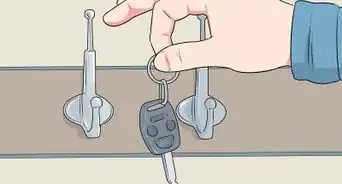This article was co-authored by Amy Wong. Amy Eliza Wong is a Leadership and Transformational Coach and the Founder of Always on Purpose, a private practice for individuals and executives looking for help in increasing personal well-being and success and in transforming work cultures, developing leaders, and improving retention. With over 20 years of experience, Amy coaches one-on-one and conducts workshops and keynotes for businesses, medical practices, non-profits, and universities. Based in the San Francisco Bay Area, Amy is a regular instructor at Stanford Continuing Studies, holds an MA in Transpersonal Psychology from Sofia University, a certification in Transformational Life Coaching from Sofia University, and a certification in Conversational Intelligence from CreatingWE Institute.
There are 10 references cited in this article, which can be found at the bottom of the page.
This article has been viewed 128,136 times.
Strengthening teamwork in an office environment can contribute to a greater sense of unity, improved productivity, and employee satisfaction. Establishing team-building goals, clarifying employee roles and responsibilities, holding regular team meetings, and organizing social activities are all effective ways to increase camaraderie and cooperation. Ideally, the lessons learned during teamwork-building exercises will carry over into day-to-day operations, making everyone work better and more efficiently.
Steps
Fostering a Collaborative Environment
-
1Share a common goal. At its core, a team is a group of people working together to accomplish a shared goal. In any teamwork-building effort, you'll need to remind your employees that they need to work together to accomplish that common goal.[1]
- Remind employees why the team they're on exists, and emphasize the importance of collaboration and cooperation.
- Prioritize team efforts based on the common goal being worked towards.
- Consider creating a motto, award, or motivational poster that emphasizes and rewards teamwork.
-
2Develop a vision statement reflecting your goal. In addition to having a shared goal, you may want to consider drafting a vision statement for your employees to follow. Your vision statement should reiterate the importance of teamwork, shared values, and inclusion in the workplace.[2]
- Your vision statement should specify what inclusion should look like in the workplace.
- Try to establish specific behavioral expectations of your team. These expectations should foster a trusting, open, and cooperative environment.
- Give concrete recommendations for your employees. Don't use abstractions or metaphor; be clear, concise, and specific.
-
3Reinforce office roles. As a manager or supervisor, your role is sort of a coach to your employees. But each employee should have a role as well. These roles should be clear to the employees, and should help work towards the shared goal you have for your company.[3]
- Review each employee's role from time to time, and remind your employees what their roles are.
- Reiterate responsibilities and expectations when delegating work and assignments.
- Help your employees find ways to help one another.
-
4Promote open communication.[4] Miscommunication is threatening to the wellbeing of any organization. It could cause the team of employees to lose focus, trust, and morale.[5]
- It's better to accidentally over-communicate than to risk under-communicating.
- Try to understand every aspect of the issue at hand.
- Clarify errors and clear up misunderstandings as soon as they arise.
- Reinforce teamwork and cooperation, and recognize your employees' efforts.
-
5Address non-cooperative behavior. At some point, if you oversee operations and lead a team of employees, you may encounter someone who rejects teamwork and has a hard time being a team player. This person may be a "loner" type, or might simply not believe in the shared goals you've laid out for your employees. No matter what the situation may be, you'll need to address this behavior head-on to prevent your other employees from feeling unsafe.[6] [7]
- Have a calm, direct conversation with your employee to address his behavior. Explain why his behavior is a problem, and encourage him to modify his behavior for the betterment of your work environment.
- Remind your employee that he's part of a team, and he must embrace the ethics and morale of that team.
- Try creating a special niche role for your employee that he can successfully and productively fill. Take his experience, skills, and length of employment into account when designing a role for him.
Using Team-Building Activities
-
1Have a clear focus. Before you turn your employees loose in a round of team-building exercises, it's important to establish what the point of each activity is and what you hope to accomplish with it. Activities can (and arguably should) be fun, but they should ultimately serve a purpose and strengthen the bonds between your employees.[8]
-
2Strengthen communication skills. One way to foster stronger communication between coworkers is to use children's building blocks to design small sculptures. This requires observation skills, strong leadership abilities, and group communication.
- Break your employees up into small teams (no more than four people per team).
- Build a small sculpture using children's building blocks. Make sure the sculpture is hidden from the teams.
- Hand out the necessary building blocks to each team.
- Choose one instructor from each team (perhaps supervisors or managers) to come up and view the sculpture at the same time. Their remaining team members should remain at their stations, out of view of the sculpture.
- Each instructor may only view the sculpture for 10 seconds at a time. After 10 seconds they must all return to their groups and direct their team mates on how to complete the sculpture.[11]
-
3Build trust. A good way to build trust between coworkers is by having one employee lead another. This is an excellent opportunity to pair together people who don't get along or don't trust one another.
- Set up an obstacle course using chairs, boxes, cones, and anything else you might have lying around the office - just be sure you don't use any objects that could hurt someone.
- Split your employees into pairs. Again, focus on pairing together people who might not work well together normally, as this is an opportunity to improve their relationship.
- Blindfold one person, and instruct him not to talk.
- Have his partner lead him through the obstacle course by giving verbal directions only. The goal is to have each blindfolded employee make it through the obstacles and reach the far side of the course.[12]
-
4Develop patience and teamwork. A good team activity for your employees is the "watch your back" exercise. This forces your employees to work together, have patience for one another, and coordinate their movements to work as a team. You can instruct your employees to carry over the coordination and patience they have for one another during this exercise into their day to day work lives.
- Make a start line and a finish line.
- Instruct everyone to stand side-by-side with their arms linked at the elbows.
- While keeping their arms linked, have your employees move together as a unit towards the finish line without losing anyone.
- To really build patience, you can time them and have your employees repeat the exercise until they can get to the finish line under a certain time limit. Figure out a time limit that is both challenging but realistic for the distance you're expecting them to cover.
-
5Have employees create a team-building activity. Having your employees devise and implement their own original team exercise can change things up and get your employees motivated to succeed. It also requires teamwork in and of itself, as each group of employees must work together to develop an activity and agree on how best to design it.[13]
- Create a fake problem. Tell your employees that you were going to spend an hour doing a problem solving activity, but you didn't want them to rehash something they've done before in the past.
- Have each group of employees devise their own unique problem-solving activity. They'll need to work together and form some type of consensus on whether the activity will work.
- Once each group has come up with their own activity, have each group of employees participate in one another's exercises.
Finding Other Ways to Build Teamwork
-
1Host office potlucks. Buying your employees a meal (like a pizza party) from time to time can help boost morale. But hosting a potluck might be even more effective at fostering a sense of teamwork and cooperation. Each employee will participate and work together to feed the staff with their own specialty, which also works as a metaphor for inter-office cooperation.[14]
- Announce the potluck a week or two in advance so that your employees can buy and prepare whatever foods they'll need.
- Ask your employees where their culinary strengths lie, and encourage them to create their own healthy, delicious contributions.
-
2Start a sports league. Team work is a vital part of office productivity. It's also a natural part of team sports, which explains why so many offices host after work sports leagues. Starting a softball or bowling league can give your employees a chance to work together as a team while also relaxing and enjoying some down time together.[15]
- Talk to other offices in your area and see if they'd be interested in joining a friendly recreational sports league.
- If other offices aren't interested, consider starting an intramural league that only involves your employees.
- Contact local venues (like ball parks and bowling alleys) to find out how to start a league, and ask about discounts available for larger teams.
-
3Consider hosting a charity event. Another great way to have your employees bond while working towards a shared goal is a charity event. You can organize your own event, or sign up your employees to join in with an existing event.[16]
- If you're starting your own event, seek feedback from your team. Talk to your employees, and ask them to vote on an event to participate in, as well as a charity to benefit from that event.
- Have employees who are interested in participating raise money or collect donations. Don't make donations mandatory, but remind your employees how important it is to help out the charity they choose.
- You can join a walkathon, for example, or simply offer your employees the opportunity to volunteer with an existing charity.
References
- ↑ https://www.opm.gov/policy-data-oversight/performance-management/teams/building-a-collaborative-team-environment/
- ↑ https://web.duke.edu/equity/resources/toolkit/how_to_build_a_more_inclusive_team.pdf
- ↑ https://www.opm.gov/policy-data-oversight/performance-management/teams/building-a-collaborative-team-environment/
- ↑ Amy Wong. Leadership & Transformational Coach. Expert Interview. 30 April 2020.
- ↑ https://www.opm.gov/policy-data-oversight/performance-management/teams/building-a-collaborative-team-environment/
- ↑ Amy Wong. Leadership & Transformational Coach. Expert Interview. 30 April 2020.
- ↑ http://www.amanet.org/training/articles/Building-a-Sense-of-Teamwork-Among-Staff-Members.aspx
- ↑ http://money.usnews.com/money/careers/slideshows/the-best-team-building-exercises/2
- ↑ http://money.usnews.com/money/careers/slideshows/the-best-team-building-exercises/4
- ↑ http://money.usnews.com/money/careers/articles/2014/09/25/corporate-team-building-activities-the-good-the-bad-and-the-really-ugly/*?page=2
- ↑ http://www.entrepreneur.com/article/249196
- ↑ https://www.mindtools.com/pages/article/newTMM_52.htm
- ↑ https://www.huddle.com/blog/team-building-activities/
- ↑ http://www.entrepreneur.com/article/249196
- ↑ http://www.entrepreneur.com/article/249196
- ↑ http://www.entrepreneur.com/article/249196

































